This herbal tea combines the properties of anise seeds with organically grown licorice. An intense taste, with qualities that soothe irritation and inflammation during digestion.
Star anise and licorice infusion: properties and benefits
The two components enhance each other, to donate their qualities to our body. Star anise is notoriously recognized as a natural antibiotic, thanks to its most interesting and aromatic active ingredient, called anethole. An element that shows ability to contrast irritations and inflammations of the organism, useful against some bacteria. In addition, it contains other effective phytochemicals such as quercetin, coumaric acid and kaempferol, with anti-inflammatory and antioxidant effects. The health benefits of star anise include constipation benefits, given its excellent amounts of fiber. Fiber builds up in the colon and along the intestinal tract, attracting water and preventing the stasis typical of constipation. Also, anise helps limit gas formation from the gastrointestinal tract. Steeping in hot water can help relieve the symptoms of seasonal ailments, colds and flu. Thanks to the antioxidants that strengthen the immune system and the presence of the compound known as shikimic acid.
It is a component used to create anti-flu treatments, and present in star anise with a high concentration in nature. The expectorant properties of this infusion, combined with licorice, also help in case of cough and phlegm, sore throat or rhinitis. Among other properties, the infusion supports night rest, being relaxing with an action on neurotransmitters and hormones. In addition, anise also helps relieve menopausal symptoms, thanks to the content of phyto-estrogens (chemical components with estrogen-like activity). Also for women, star anise is considered a galactogen, because traditionally the use of this spice stimulates the production of milk in new mothers.
Today's research focuses on anethole: the compound is believed to have a structure similar to dopamine – a substance that inhibits the release of prolactin (hence, milk production). By occupying the place of dopamine, and displacing it from its receptors, anise can prevent this "blockage", and increase milk production. The compound anethole found in star anise also possesses antifungal properties, usually used topically via the essential oil.
In any case, even when it is consumed, it can have a good impact to normalize the candida fungal colonies of the body. These colonies are part of the natural flora in women, but when they are out of balance, star anise inhibits the overgrowth of fungal organisms. Furthermore, the iron richness of star anise can be useful for a correct production of red blood cells, especially in combination with other minerals and vitamins. Star anise is also rich in calcium, an important component of bones, and in vitamin C which is beneficial for the beauty of the skin. This vitamin helps the production of collagen, which can prevent the appearance of wrinkles. Licorice brings to this infusion its natural anti-inflammatory properties, useful in case of sore throat, colds, headaches. Its anti-inflammatory active ingredient is glycyrrhizin. At the digestive level, it is excellent as a digestive ingredient due to its action in contrasting gastroesophageal reflux, in addition to its advantageous qualities in contrasting constipation and slow digestion.
Furthermore, licorice amplifies the expectorant qualities of anise, adding a purifying and diuretic note. Furthermore, licorice helps to counteract liver disorders, and is thirst-quenching. The taste of anise is similar to the decisive one of licorice. The sum of these two ingredients creates a unique herbal tea, in terms of delicacy and benefits, to try and enjoy.
Origins and History of cultivation
Star anise is a spice used around the world for its lively flavor, as it gives a unique taste, which makes many foods extremely delicious. Also known as Chinese star anise or badiam, it is obtained from the fruit of a plant native to southern China and the northern areas of Vietnam, but is not grown in other Southeast Asian states. Star anise is different from aniseed, even if their flavors are the same (anise is also present in our infusion).
Star anise is used extensively in Asian cuisine, while anise seeds are used predominantly in Western cultures. Anise was already used by the Egyptians, Greeks and Romans to promote digestion, giving health to the stomach and intestines. Today both are used everywhere, thanks to widespread availability and the desire to experiment with flavors on the table. Star anise has different benefits than anise seeds, but both are used for health purposes. The extraction of star anise essential oil is known in herbal medicine, which is used for the preparation of medicines and natural remedies. It is also used for the production of various liqueurs including sambuca, pastis, sassolino and for mistrà. Licorice, on the other hand, has been known since ancient times in Europe and Asia, being a plant native to these two continents. Already mentioned in the oldest Chinese herbarium, it has always been used to treat coughs, food poisoning and the liver.
Also known to the Egyptians, it seems that it is also present in the tombs of the pharaohs! It was even considered magical in the Middle Ages, when it was spread by the Dominican friars. To obtain the products we know as shiny and black, the sticks of the licorice root are ground up and the juice is extracted from the paste thus obtained, boiled and transformed into a thick liquid. From there the polishing and cutting into the desired shapes for the pastry will start. In our organic licorice infusion, it is present in a natural version with sticks mixed with anise, cornflower and star anise.
Plant and flowers
The anise plant is Illicium verum, a tropical evergreen tree of the Schisandraceae family. It can reach a height between 5-10 meters. It has large glossy green foliage and white flowers of great decorative value: they are petals arranged in a spiral. The star anise fruit shows about eight carpels that form the star-shaped fruit - that's why it is called star anise. Each lobe carries a seed, while licorice has the botanical name of Glycyrrhiza glabra.
It is a perennial herbaceous plant native to southwestern Asia and the Mediterranean area, known for its roots that provide the sweet compound for confectionery, glycyrrhizin. The name comes from the Greek "sweet root". To grow the licorice plant requires deep, well-cultivated, fertile and moisture-rich soil. Plant growth is initially slow, but once established, it can become weedy. Nutritional values of the infusion with star anise and organic licorice Anise contains dietary fiber, salts and minerals such as potassium, calcium, iron, magnesium. In addition, it has vitamins A, B6, C. Its best known active ingredients are anethole and shikimic acid. Licorice, on the other hand, also contains B group vitamins (vitamin B1, B2, B3 and B5), vitamin E and discrete quantities of calcium, iron, phosphorus, potassium, magnesium and zinc.
How to use star anise and licorice in herbal tea
The infusion is obtained by placing about 3-5 grams of the star anise and organic licorice mixture in a cup (250 ml), with water at 100 °C. Leave to infuse for 10 to 12 minutes, before drinking the herbal tea. Add honey or sugar, if desired.
Star anise and licorice infusion: side effects and contraindications
i It is recommended to maintain the correct doses of this infusion, since the abuse of licorice and star anise can give rise to side effects. You may experience an increase in blood pressure, water retention, headache, vomiting, nervousness. It is not recommended for use by hypertensives, those suffering from renal insufficiency, and diabetics as they are two sweetening plants. It should also be taken with caution during pregnancy.



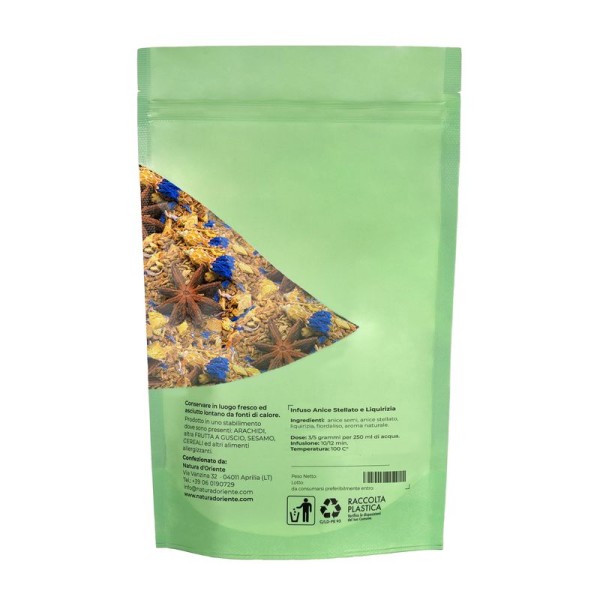







 No reward points for this product.
No reward points for this product.
![infuso lime mirtilli rossi [Natura d'Oriente]](https://www.naturadoriente.com/3551-home_default/lime-infused-cranberries.jpg)
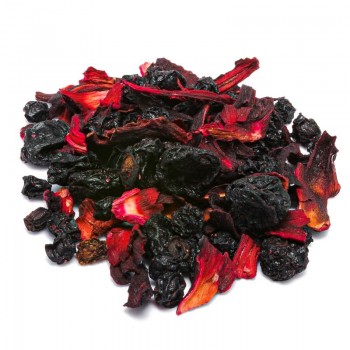
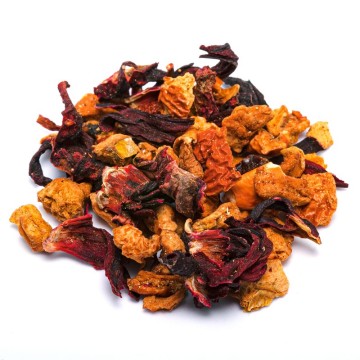
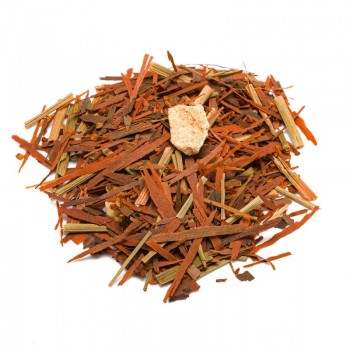

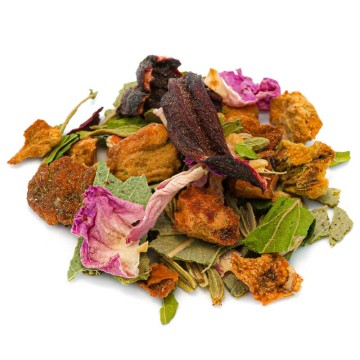





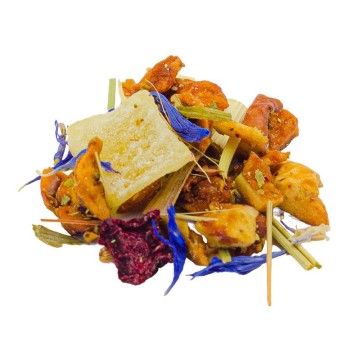

![infuso pesca melone [Natura d'Oriente]](https://www.naturadoriente.com/3535-home_default/infused-peach-melon.jpg)
![infuso pesca e vaniglia [Natura d'Oriente]](https://www.naturadoriente.com/3538-home_default/infused-peach-vanilla.jpg)
